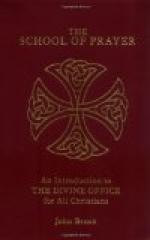The new Breviary contains a tabella of Dominical letters, up to the year 2000 A.D. It needs no comment.
Indiction. Indiction was a cycle of fifteen years, the first of which dated from the third year of the Christian era. It was usual to indicate the number of the year in a cycle and no mention was made of the cycles already completed. Thus, the indictio sexta meant the sixth year of a cycle and not the sixth cycle or period of fifteen years. Hence, to know the year of indiction is useless for determining the date in old documents of State. Indiction was instituted by Constantine in 313 for fiscal purposes. In papal and imperial documents the name of Pope or emperor was generally given and the regnal years noted.
Movable Feasts. In virtue of the decree of the Council of Nice, in 325, Easter, on which all other movable feasts depend, must be celebrated on the Sunday which follows immediately the fourteenth day of the moon of the first month (in the Hebrew year), our March. Easter, then, is the first Sunday after the Paschal full moon (i.e., the full moon which happens upon or next after March 21st). If full moon happens on a Sunday, Easter Sunday is the Sunday after the full moon. The matter of the arrangement of Easter was for long a subject of very bitter contention in the Irish and in the English Church. The Irish, clinging tenaciously to the calendar of St. Patrick, carried it everywhere in their missionary labours, so that the controversy was not confined to Ireland and England. It was long and bitter, until at last the Irish Church agreed to follow the reform. (See Healy, Ireland’s Schools and Scholars, p. 592; Moran, Irish Saints in Great Britain, “The Conference at Whitby in 664,” pp. 255-261).
Calendar study is interesting, and many valuable contributions on this matter have been given to us by Father Thurston, S.J., and other English and Irish scholars.
GENERAL RUBRICS OF THE BREVIARY.
The next document in the Breviary, Part I., has the title “Rubricae Generates Breviarii,” the general rubrics of the Breviary. They are called general, as they apply to every part of the Breviary and are to be distinguished from the rubrics dealing with the proper (proprium) of the Breviary, the proper of time or of the saints. The word “rubrics” was originally applied to the red marking lines used by carpenters on wood, later it referred to the titles used by jurisconsults in announcing laws, which were written in red colours. The word appears in Church literature to refer to signs and directions as early at least as the fourteenth century (Cath. Encyclopedia—word “rubrics").




